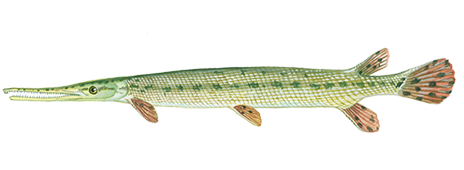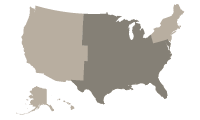
Longnose Gar
The longnose gar is the most common and widely distributed of all the gars.

Region
Midwest, South
Catch ease
Medium
Habitat
Lake, River, Pond
How to identify a Longnose Gar
This gar is generally distinguished from other gars by it longer, more slender body, and especially by its longer, narrower beak (18-20 times as long as it is wide at its narrowest point). The longnose gar is brown or dark green on the top and sides with a cream or white belly. Spots are scattered on the fins and in some specimens, the body. The nostrils are located in a small, bulbous fleshy growth at the very tip of the upper jaw. The bony, diamond shaped ganoid scales of all gar species overlap to form a very strong and protective armor on the body that has been known to deflect arrows.
Where to catch Longnose Gar
It is found throughout the eastern half of the United States through the Mississippi River system and other drainages in larger streams and in brackish water coastal inlets. Its range extends at least as far south as Florida’s Lake Okeechobee, the Gulf States, and the Rio Grande between Texas and Mexico; and as far north as Minnesota, the Great Lakes, and Quebec, Canada although the longnose gar is not as common in its far northern reaches. It rarely occurs west of Minnesota but has been found as far west as Montana in the north and New Mexico to the south. It is found both east and west of the Appalachians, with large concentrations along the Atlantic coast states. The following list includes additional details on where to catch this fish:
| Channel Entrances |
| Freshwater Lakes and Ponds |
| Inlets and Outlets |
| Islands or Sand Bars |
| Overhanging Trees and Bushes |
| Rivers and Streams |
| Merging Currents |
| Spring Holes |
| Walkways and Bridges |
| Cliffs and Steep Shore Banks |
| Gradual Shores |
| Inside Turns and Coves |
| Open Water |
| Piers, Docks and Pilings |
| Rocks |
| Shoreline Shallows |
| Sunken Objects |
How to catch Longnose Gar
Longnose gar are known to be wild fighters but put up a short fight after being hooked. Spinning and baitcasting tackle are the most common choices used by gar anglers. This species can be taken on a variety of artificial lures but the most effective baits are small live baits or cut bait. Although edible, the longnose gar is not popular and the eggs are poisonous, causing severe illness in humans and sometimes death in smaller animals and birds. Only fish seem to be able to consume these eggs without harm. The following are fishing methods used to catch this fish:
Longnose Gar lures, tackle & bait
The following are lures, tackle or bait that can be used to catch this fish:
